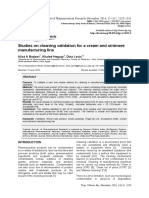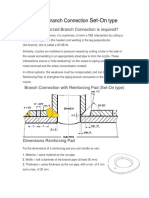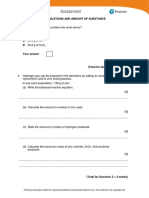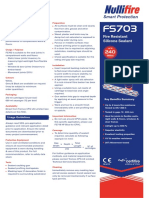KB003
KB003
Uploaded by
sppCopyright:
Available Formats
KB003
KB003
Uploaded by
sppOriginal Title
Copyright
Available Formats
Share this document
Did you find this document useful?
Is this content inappropriate?
Copyright:
Available Formats
KB003
KB003
Uploaded by
sppCopyright:
Available Formats
TM
KB003 Hi25 Enterobacteriaceae Identification Kit
Introduction
KB003 is a comprehensive test system that can be used for identification of gram-negative Enterobacteriaceae species. Organisms belonging to Enterobacteriaceae are gram negative,
oxidase negative, nitrate positive rods and are the most frequently isolated bacteria from clinical specimens. Hi25™ identification kit can be used for screening pathogenic organisms
from urine, enteric specimens and other relevant clinical samples. It can also be used for validating known laboratory strains. The complete list of organisms that can be identified with
this system is given in the identification index provided with the kit.
Principle
Each Hi25™ kit is a standardized colorimetric identification system utilizing thirteen conventional biochemical tests and eleven carbohydrate utilization tests. The tests are based on
the principle of pH change and substrate utilization. On incubation organisms undergo metabolic changes which are indicated by a colour change in the media that is either visible
spontaneously or after addition of a reagent. Oxidase test is performed separately using oxidase reagent disc provided with the kit.
Kit contents
1. Each kit contains sufficient material to perform 10 tests. 8. TDA reagent (R036) for Phenylalanine Deaminase test.
2. 10 kits of Part I. 9. Baritt reagent A (R029) for Voges-Proskauer's test.
3. 10 kits of Part II. 10. Baritt reagent B (R030) for Voges-Proskauer's test.
4. Oxidase reagent discs (DD018) 11. Methyl Red reagent (I007) for Methyl Red test
5. Technical product insert. 12. Kovac's reagent (R008) for Indole test
6. Result Interpretation Chart and Result Entry Datasheet. 13. Sulphanilic acid (R015)
7. Identification Index. 14. N,N-Dimethyl-1-Napthylamine Reagent (R009).
Instructions for use
1. Preparation of inoculum
KB003 cannot be used directly on clinical specimens. The organisms to be identified have to be first isolated and purified. Only pure cultures should be used.
Isolate the organism to be identified on a common medium like Nutrient Agart (M001/ M1274) or a differential medium like MacConkey Agar (M082)..
Pick up a single isolated colony and inoculate in 5 ml Brain Heart Infusion Broth and incubate at 35-37°C for 4-6 hours until the inoculum turbidity is ³ 0.1OD at 620nm or 0.5
McFarland standard. Some fastidious organisms may require more than 6 hours of incubation. In this case incubate till the inoculum turbidity reaches 0.1OD at 620nm.
Alternatively, prepare the inoculum by picking 1-3 well isolated colonies and make a homogenous suspension in 2-3ml sterile saline. The density of the suspension should
be 0.1OD at 620nm.
Perform Oxidase test on the organism to be tested. The test is performed using Oxidase disc (DD018) provided with the kit.
Pick up a well isolated colony and rub it on a single oxidase disc. Positive reaction is indicated by development of deep purple colour within 10 seconds. Colour
change in 10-60 seconds indicates a delayed positive reaction. Colour development after 60 seconds or no change in colour indicates a negative reaction.
Note the result in the Result Entry Datasheet. Oxidase test must be performed as it is an integral part of the identification system. It must be performed to differentiate
Enterobacteriaceae from other gram negative rods.
Note Erroneous false negative results may be obtained if the inoculum turbidity is less than 0.1 OD.
Results are more prominent if an enriched culture is used instead of suspension.
2. Inoculation of the kit
Open the kit aseptically. Peel off the sealing foil. Inoculate each well with 50 µl of the above inoculum by surface inoculation method.
Alternatively, the kit can also be inoculated by stabbing each individual well with a loopful of inoculum.
3. Incubation : Temperature of incubation: 35 ± 2°C. Duration of incubation: 18 - 24 hours.
Interpretation of results :
Interpret results as per the standards given in the identification index. Addition of reagents wherever required should be done at the end of incubation period that is after
18 - 24 hours.
Part I : Phenylalanine Deamination Test : Well No. 5
Add 2-3 drops of TDA reagent (R036). Development of dark green colour within one minute indicates a positive reaction.
No change in colour denotes a negative reaction.
Nitrate Reduction Test : Well No. 6 Add 1-2 drops of Sulphanilic acid (R015) and 1-2 drops of N,N-Dimethyl-1-Napthylamine Reagent (R009).
Immediate development of pinkish red colour on addition of reagent indicates positive reaction. No change in colour indicates a negative reaction.
Voges Proskauer's Test : Well No. 9 Add 2-3 drops of Baritt reagent A (R029) and 1 drop of Baritt reagent B(R030).
Pinkish red colour development within 5-10 minutes indicates a positive test.
No change in colour or a slight change in colour (due to reaction of Baritt reagent A with Baritt reagent B) denotes a negative reaction.
Methyl Red Test : Well No. 10 Add 1-2 drops of Methyl Red reagent (I007).
Reagent remains red in colour if the test is positive.
Reagent decolourises and becomes yellow if the test is negative.
Indole Test : Well No. 11 Add 1-2 drops of Kovac's reagent (R008).
Development of pinkish red colour within 10 seconds indicates positive reaction.
Reagent remains pale coloured if the test is negative.
Please refer disclaimer Overleaf.
HiMedia Laboratories Technical Data
Identification Index of various Enterobacteriaceae species
Tests ONPG Lysine Ornithine Urease TDA Nitrate H2S Citrate Utilization Voges Proskauer's Methyl Red Indole Malonate
Budvicia aquatica
Buttiauxella agrestis
Cedecea davisae
Cedecea lapagei
Cedecea neteri
Citrobacter amalonaticus
Citrobacter diversus
Citrobacter freundii
Enterobacter aerogenes
Enterobacter amnigenus (Biogroup I)
Enterobacter amnigenus (Biogroup II)
Enterobacter taylorae (E. cancerogenus)
Enterobacter cloacae
Enterobacter gergoviae
Enterobacter sakazakii
Escherichia coli
Escherichia coli, inactive
Escherichia blattae
Escherichia fergusonii
Escherichia hermannii
Escherichia vulneris
Ewingella americana
Hafnia alvei
Klebsiella oxytoca
Klebsiella pneumoniae
subspecies ozaenae
Klebsiella pneumoniae subspecies pneumoniae
Klebsiella pneumoniae subspecies
rhinoscleromatis
Klebsiella terrigena
Kluyvera ascorbata
Leclercia adecarboxylata
(Escherichia adecarboxylata)
Morganella morganii subspecies morganii
Morganella morganii subspecies sibonii
Pantoea agglomerans
Pantoea dispersa
Proteus mirabilis
Proteus myxofaciens
Proteus penneri
Proteus vulgaris
Providencia alcalifaciens
Providencia rettgeri
Providencia rustigianii
Rahnella aquatilis
Salmonella bongori
Salmonella choleraesuis subspecies arizonae
Salmonella choleraesuis
subspecies choleraesuis
Salmonella choleraesuis subspecies diarizonae
Salmonella choleraesuis subspecies houtenae
Salmonella choleraesuis subspecies indica
Salmonella choleraesuis subspecies salamae
Salmonella enteritidis
Salmonella typhi
Salmonella typhimurium
Serratia entomophila
Serratia ficaria
Serratia fonticola
Serratia marcescens
Serratia odorifera (Biogroup I)
Serratia odorifera (Biogroup II)
Serratia plymuthica
Serratia proteamaculans
Serratia rubidaea
Shigella boydii, Shigella flexneri,
Shigella dysenteriae
Shigella sonnei
Yersinia enterocolitica
Yersinia frederiksenii
Yersinia intermedia
Yersinia pestis
Yersinia pseudotuberculosis
Note : Based on % strains showing reactions following symbols have been assigned from laboratory results and standard references.
+ = Positive (more than 90%) = Negative (more than 90%) V = 11-89% positive.
Please refer disclaimer Overleaf.
HiMedia Laboratories Technical Data
KB003 : Hi25TM Enterobacteriaceae Identification Kit
Identification Index of various Enterobacteriaceae species
Esculin hydrolysis Arabinose Xylose Adonitol Rhamnose Cellobiose Melibiose Saccharose Raffinose Trehalose Glucose Lactose
Note : Based on % strains showing reactions following symbols have been assigned from laboratory results and standard references.
+ = Positive (more than 90%) = Negative (more than 90%) V = 11-89% positive.
Please refer disclaimer Overleaf.
HiMedia Laboratories Technical Data
Strip I Result Interpretation chart
No. Test Reagents to be added Principle Original colour Positive Negative
after incubation of the medium reaction reaction
1 ONPG — Detects b-galactosidase activity Colourless Yellow Colourless
2 Lysine Olive green to Purple / Dark
utilization — Detects Lysine decarboxylation Light Purple Purple Yellow
3 Ornithine Olive green to Purple / Dark
utilization — Detects Ornithine decarboxylation Light Purple Purple Yellow
4 Urease — Detects Urease activity Orangish yellow Pink Orangish yellow
5 Phenylalanine 2-3 drops of TDA reagent Detects Phenylalanine Colourless Green Colourless
Deamination deamination activity
6 Nitrate 1-2 drops of sulphanilic Detects Nitrate reduction Colourless Pinkish Red Colourless
reduction acid and 1-2 drops of N,
N-Dimethyl-1-Napthylamine
7 H2S production — Detects H2S production Orangish yellow Black Orangish yellow
8 Citrate utilization — Detects capability of organism to Green Blue Green
utilize citrate as a sole carbon source
9 Voges 1-2 drops of Baritt reagent A Detects acetoin production Colourless / Light Pinkish red Colourless/
Proskauer's and 1-2 drops of Baritt reagent B Yellow slight copper
10 Methyl red 1-2 drops of Methyl red reagent Detects acid production Colourless Red Yellowish- orange
11 Indole 1-2 drops of Kovac's red reagent Detects deamination of tryptophan Colourless Pinkish Red Colourless
12 Malonate — Detects capability of organism to Light green Blue Light green
utilization utilize sodium malonate as a sole
carbon source
Strip II Result Interpretation chart
No. Test Principle Original colour Positive Negative
of the medium reaction reaction
13 Esculin hydrolysis Esculin hydrolysis Cream Black Cream
14 Arabinose Arabinose utilization Pinkish Red / Red Yellow Red / Pink
15 Xylose Xylose utilization Pinkish Red / Red Yellow Red / Pink
16 Adonitol Adonitol utilization Pinkish Red / Red Yellow Red / Pink
17 Rhamnose Rhamnose utilization Pinkish Red / Red Yellow Red / Pink
18 Cellobiose Cellobiose utilization Pinkish Red / Red Yellow Red / Pink
19 Melibiose Melibiose utilization Pinkish Red / Red Yellow Red / Pink
20 Saccharose Saccharose utilization Pinkish Red / Red Yellow Red / Pink
21 Raffinose Raffinose utilization Pinkish Red / Red Yellow Red / Pink
22 Trehalose Trehalose utilization Pinkish Red / Red Yellow Red / Pink
23 Glucose Glucose utilization Pinkish Red / Red Yellow Red / Pink
24 Lactose Lactose utilization Pinkish Red / Red Yellow Red / Pink
25 Oxidase Done on Oxidase disc separately. Colourless Deep purple White/
Detects cytochrome oxidase production. within 10 seconds Purple after 60 seconds
Important points to be taken into consideration while interpreting the result :
1. Allow the reagents to come to room temperature after removal from the refrigerator .
2. In case of carbohydrate fermentation test some microorganisms show weak reaction. In this case record the reaction as ± and incubate further for 48 hours.
Orange colour after 48 hours of incubation should be interpreted as a negative reaction.
3. In case of Lysine and Ornithine decarboxylation, incubation up to 48 hours may be required.
4. At times organisms give conflicting result because of mutation or the media used for isolation, cultivation and maintenance.
5. The identification index has been compiled from standard references and results of tests carried out in the laboratory.
Precautions :
Clinical samples and microbial cultures should be considered potentially pathogenic and handled accordingly.
Aseptic conditions should be maintained during inoculation and handling of the kits.
Reagents should not come in contact with skin, eyes or clothing.
Disposal of used material :
After use, kits and the instruments used for isolation and inoculation (pipettes, loops etc.) must be disinfected using a suitable disinfectant and then discarded by
incineration or autoclaving in a disposal bag.
Storage & Shelf-life
Store at 2-8°C. Shelf-life is 12 months.
Disclaimer :
User must ensure suitability of the product(s) in their application prior to use. Products conform solely to the information contained in this
and other related HiMedia™ publications. The information contained in this publication is based on our research and development work
and is to the best of our knowledge true and accurate. HiMedia™ Laboratories Pvt Ltd reserves the right to make changes to specifications
and information related to the products at any time. Products are not intended for human or animal diagnostic or therapeutic use but for
laboratory, research or further manufacturing use only, unless otherwise specified. Statements contained herein should not be considered
as a warranty of any kind, expressed or implied, and no liability is accepted for infringement of any patents.
HiMedia Laboratories Pvt. Ltd. A-516,Swastik Disha Business Park,Via Vadhani Ind. Est., LBS Marg, Mumbai-400086, India. Customer care No.: 022-6147
1919 Email: techhelp@himedialabs.com
You might also like
- Formulation 2Document38 pagesFormulation 2sppNo ratings yet
- Identification of IonsDocument3 pagesIdentification of IonsRayyan AhsanNo ratings yet
- tr2608 Toc PDFDocument10 pagestr2608 Toc PDFspp100% (1)
- Enteropluri Code Book 7-2013Document229 pagesEnteropluri Code Book 7-2013bobNo ratings yet
- Teco Diagnostics: Alt (SGPT) Liquid Reagent (Kinetic Method)Document2 pagesTeco Diagnostics: Alt (SGPT) Liquid Reagent (Kinetic Method)Wendy ZacaríasNo ratings yet
- RAMS Example 1Document11 pagesRAMS Example 1sppNo ratings yet
- 5205 en 1Document2 pages5205 en 1Melisa NicevićNo ratings yet
- M148-ACETAMIDE BROTHDocument3 pagesM148-ACETAMIDE BROTHlabmicrobiologiaindustrialciaNo ratings yet
- Hicrome™ Ecc Selective Agar Base: Intended Use: CompositionDocument3 pagesHicrome™ Ecc Selective Agar Base: Intended Use: Compositionafiifa1015No ratings yet
- Vital Widal IfuDocument2 pagesVital Widal IfuMuhammad Rizaldi RidwanNo ratings yet
- Technical Data: Peptone WaterDocument3 pagesTechnical Data: Peptone WaterAbdulrahmanNo ratings yet
- Sop-Clinical PathologyDocument25 pagesSop-Clinical PathologyAniruddha Chatterjee100% (1)
- Indole TestDocument3 pagesIndole TestNisha HernandezNo ratings yet
- 2018 - 12039 - Application Note Inactivation of Disinfectants Using TSA Based ICR Contact Plates With Different Neutralizers (Merck)Document6 pages2018 - 12039 - Application Note Inactivation of Disinfectants Using TSA Based ICR Contact Plates With Different Neutralizers (Merck)Florina MocanuNo ratings yet
- Methyl Red Indicator: Intended Use: CompositionDocument2 pagesMethyl Red Indicator: Intended Use: CompositionAli HamzaNo ratings yet
- 1. M1339 Tryptophan MediumDocument2 pages1. M1339 Tryptophan MediumirvanNo ratings yet
- Oxi DropDocument4 pagesOxi DropTejas SNo ratings yet
- Kovac's Indole Reagent: Intended UseDocument2 pagesKovac's Indole Reagent: Intended UseShamim MahmudNo ratings yet
- BETA-SSA Agar (Group A Streptococci Selective Agar)Document3 pagesBETA-SSA Agar (Group A Streptococci Selective Agar)uttam.micro404No ratings yet
- Nephchem ASODocument1 pageNephchem ASOsobujNo ratings yet
- RA45Document3 pagesRA45marsyatimbuli16No ratings yet
- DD025Document3 pagesDD025Gounder KirthikaNo ratings yet
- ASI Infectious MonoDocument4 pagesASI Infectious MonocarineNo ratings yet
- Vit D TurbiDocument2 pagesVit D TurbiAmrNo ratings yet
- Indole Test Clinical Bacteriology MLT 3102Document6 pagesIndole Test Clinical Bacteriology MLT 3102amnashehzadi731No ratings yet
- Report_NeutralizerA-inactivation of disinfectants_fnl (2)Document20 pagesReport_NeutralizerA-inactivation of disinfectants_fnl (2)Florina MocanuNo ratings yet
- Peptone Water: Intended Use: CompositionDocument3 pagesPeptone Water: Intended Use: Composition10605114No ratings yet
- Dey-Engley Neutralizing BrothDocument2 pagesDey-Engley Neutralizing BrothAnonymous WxIzg7tNo ratings yet
- M352Document3 pagesM352DBPNo ratings yet
- Vi Biochemical CharacterizationDocument2 pagesVi Biochemical Characterizationashra sindhikkaaNo ratings yet
- MH581Document3 pagesMH581Abid Iqbal ARDNo ratings yet
- Plate Count Agar (Standard Methods Agar) : Intended UseDocument3 pagesPlate Count Agar (Standard Methods Agar) : Intended UsenuraenirianNo ratings yet
- WesternblotDocument46 pagesWesternblotcaanietoclNo ratings yet
- H-046-000340-00 D-Bil (VOX)Document30 pagesH-046-000340-00 D-Bil (VOX)bikouvoNo ratings yet
- Eugon LT 100 BrothDocument2 pagesEugon LT 100 BrothSergei VoychukNo ratings yet
- Eritrocitos Draize PDFDocument5 pagesEritrocitos Draize PDFGladys Emilia Venegas AveledoNo ratings yet
- TDS M317Document3 pagesTDS M317darrendelfinoy9No ratings yet
- (ADA) Package Insert (CE)Document31 pages(ADA) Package Insert (CE)Sinari AlfatNo ratings yet
- @@@variability in The LAL TestDocument3 pages@@@variability in The LAL TestbhanifNo ratings yet
- Ce Ivd Instructions CEIVD15 enDocument3 pagesCe Ivd Instructions CEIVD15 enTanveerNo ratings yet
- 2180 en 4Document2 pages2180 en 4Melisa NicevićNo ratings yet
- Urea Broth Base (Diagnostic Stuarts Urea Broth Base) : Intended UseDocument3 pagesUrea Broth Base (Diagnostic Stuarts Urea Broth Base) : Intended Use10605114No ratings yet
- Ifu Reagent-Kit Ver-25may2022Document4 pagesIfu Reagent-Kit Ver-25may2022Mohamed SobhyNo ratings yet
- ASO APT AbDocument2 pagesASO APT AbQC LabNo ratings yet
- Sim (Sulfide, Indole, Motility) Medium: Intended UseDocument7 pagesSim (Sulfide, Indole, Motility) Medium: Intended UseLilik WahyuningsihNo ratings yet
- Qualitative Analysis of Asparagus Racemosus Willd. (Shatavari) Root of Family AsparagaceaeDocument7 pagesQualitative Analysis of Asparagus Racemosus Willd. (Shatavari) Root of Family AsparagaceaeIJRASETPublicationsNo ratings yet
- YasmeenDocument5 pagesYasmeenyasmeen.abdulah1977No ratings yet
- Alkaline Phosphatase (Dea) : Manufacturer: Biolabo SasDocument2 pagesAlkaline Phosphatase (Dea) : Manufacturer: Biolabo SasRury Darwa Ningrum100% (1)
- Biochemical Tests FinalDocument30 pagesBiochemical Tests Finalahmed.mo.22555417No ratings yet
- HHV8Document2 pagesHHV8Miriam GarcíaNo ratings yet
- Toxoplasma Gondii Igg Avidity Test: NovalisaDocument8 pagesToxoplasma Gondii Igg Avidity Test: NovalisaAghnia Asy S.No ratings yet
- Sodium Reagent Kit (Mono Test) : Colorimetric MethodDocument1 pageSodium Reagent Kit (Mono Test) : Colorimetric MethodFazal RazaNo ratings yet
- Monolisa™ HCV Ag-Ab ULTRADocument17 pagesMonolisa™ HCV Ag-Ab ULTRAGail IbanezNo ratings yet
- Noro LiferiveDocument8 pagesNoro Liferivevetrohdes aliNo ratings yet
- VRBD Sigma DatDocument2 pagesVRBD Sigma DatNeidy FloresNo ratings yet
- 1227 en 4Document2 pages1227 en 4Melisa NicevićNo ratings yet
- Elecsys T4: Cobas e 411 Cobas e 601 Cobas e 602 English System InformationDocument5 pagesElecsys T4: Cobas e 411 Cobas e 601 Cobas e 602 English System InformationIsmael CulquiNo ratings yet
- TDS K044Document3 pagesTDS K044darren.smartlabNo ratings yet
- DD018-Oxidase DiscsDocument2 pagesDD018-Oxidase Discsflorengrace.fg98No ratings yet
- Enterococcus Culture Identification Test: ReagentsDocument4 pagesEnterococcus Culture Identification Test: ReagentsJit Mann KaursekhonNo ratings yet
- Phosphorus, Reactive (Ortho Phosphate 0.3-45 PPM)Document6 pagesPhosphorus, Reactive (Ortho Phosphate 0.3-45 PPM)JinalNo ratings yet
- Lysine Decarboxylase PDFDocument3 pagesLysine Decarboxylase PDFSherly MardianaNo ratings yet
- Zhang Asu 0010E 15975Document148 pagesZhang Asu 0010E 15975sppNo ratings yet
- DPS 2012 3 2 300 304Document5 pagesDPS 2012 3 2 300 304sppNo ratings yet
- CN103169756B - Pharmaceutical Composition of Water-Soluble Vitamins For Injection, Fat-Soluble Vitamin Injection and Fat Emulsion Injection - Google PatentsDocument3 pagesCN103169756B - Pharmaceutical Composition of Water-Soluble Vitamins For Injection, Fat-Soluble Vitamin Injection and Fat Emulsion Injection - Google PatentssppNo ratings yet
- US8809393B2 - Injectable Preparations of Diclofenac and Its Pharmaceutically Acceptable Salts - Google PatentsDocument10 pagesUS8809393B2 - Injectable Preparations of Diclofenac and Its Pharmaceutically Acceptable Salts - Google PatentssppNo ratings yet
- ECDD 37th Report FINAL PrelayoutDocument45 pagesECDD 37th Report FINAL PrelayoutsppNo ratings yet
- Rapid and Efficient High-Performance Liquid Chromatography Analysis of N-Nitrosodimethylamine Impurity in Valsartan Drug Substance and Its ProductsDocument12 pagesRapid and Efficient High-Performance Liquid Chromatography Analysis of N-Nitrosodimethylamine Impurity in Valsartan Drug Substance and Its ProductssppNo ratings yet
- Dareoct 19Document6 pagesDareoct 19sppNo ratings yet
- Risk Assessments and Sourcing Strategies For Excipients and ApisDocument2 pagesRisk Assessments and Sourcing Strategies For Excipients and ApissppNo ratings yet
- PERFORMANCE QUALIFICATION PROTOCOL AUTOMATIC SIX HEAD LIQUID FILLING AND SEALING MACHINE - PDFDocument5 pagesPERFORMANCE QUALIFICATION PROTOCOL AUTOMATIC SIX HEAD LIQUID FILLING AND SEALING MACHINE - PDFspp100% (1)
- Salient Features of IP 2022pdfDocument10 pagesSalient Features of IP 2022pdfsppNo ratings yet
- CN103239461A - Vitamin B Complex Injection and Preparation Method Thereof - Google PatentsDocument3 pagesCN103239461A - Vitamin B Complex Injection and Preparation Method Thereof - Google PatentssppNo ratings yet
- PIC/S Assessment & Joint Reassessment ProgrammeDocument15 pagesPIC/S Assessment & Joint Reassessment ProgrammesppNo ratings yet
- Supplier Qualification...Document5 pagesSupplier Qualification...elmiraNo ratings yet
- Optimization and Use of Talc in Direct Compression Tablet FormulaDocument307 pagesOptimization and Use of Talc in Direct Compression Tablet FormulasppNo ratings yet
- List of Units Indore SEZ PithampurDocument4 pagesList of Units Indore SEZ PithampursppNo ratings yet
- Levofloxacin: The International PharmacopoeiaDocument7 pagesLevofloxacin: The International PharmacopoeiasppNo ratings yet
- Studies On Cleaning Validation For A Cream and Ointment Manufacturing LineDocument7 pagesStudies On Cleaning Validation For A Cream and Ointment Manufacturing LinesppNo ratings yet
- Composition of A Dossier To Register A Drug: The ContraindicationsDocument2 pagesComposition of A Dossier To Register A Drug: The ContraindicationssppNo ratings yet
- MICLAB 150 Initial Investigation of Out of Specification (OOS) Results in Microbiological LaboratoryDocument11 pagesMICLAB 150 Initial Investigation of Out of Specification (OOS) Results in Microbiological Laboratoryspp100% (2)
- (PDF) a General LC-MS - MS Method for Monitoring Potential Β-Lactam Contamination in Drugs and Drug-Manufacturing SurfacesDocument16 pages(PDF) a General LC-MS - MS Method for Monitoring Potential Β-Lactam Contamination in Drugs and Drug-Manufacturing SurfacessppNo ratings yet
- B 2800649 DDDocument28 pagesB 2800649 DDsppNo ratings yet
- Article Wjpps 1470014870Document14 pagesArticle Wjpps 1470014870sppNo ratings yet
- ACFrOgD7Jidl5a2EmEgcew0BhDkc4u 5U6FejmduZc5Y23oD2sTt2aJd vnJDHW2b57AFwVZDuFD0Nk8w5eBeWbQJbAKblubbksbQZRfTX0Toqd4DagM0T596ATI4 QDocument3 pagesACFrOgD7Jidl5a2EmEgcew0BhDkc4u 5U6FejmduZc5Y23oD2sTt2aJd vnJDHW2b57AFwVZDuFD0Nk8w5eBeWbQJbAKblubbksbQZRfTX0Toqd4DagM0T596ATI4 QsppNo ratings yet
- Beta Lactam Inactivation PDFDocument11 pagesBeta Lactam Inactivation PDFsppNo ratings yet
- Schmincke Horadam OldDocument16 pagesSchmincke Horadam Oldtemporar emailNo ratings yet
- 3-Group III A and Group IV A Elements Ok-1Document17 pages3-Group III A and Group IV A Elements Ok-1hassan tariqNo ratings yet
- 1222 Terminal SterilizationDocument4 pages1222 Terminal SterilizationSpectre SpectreNo ratings yet
- Delta-Protekt VH 300Document4 pagesDelta-Protekt VH 300AndrewNo ratings yet
- 2016 IOGPGas Oil Industry NORMreport 412Document69 pages2016 IOGPGas Oil Industry NORMreport 412WrodolfoEPNNo ratings yet
- Fluorolined PVDF Series III Horizontal Pump 558434Document14 pagesFluorolined PVDF Series III Horizontal Pump 558434khaled younis100% (1)
- 9 Surfing - Equilibrium & TemperatureDocument2 pages9 Surfing - Equilibrium & TemperatureEliNo ratings yet
- Electrode Potential, Ecell, Nernst Equation and EcsDocument8 pagesElectrode Potential, Ecell, Nernst Equation and Ecssasanka shawNo ratings yet
- 7A Cells Crossword: Water Quickly. (4,4,4) Happen.Document14 pages7A Cells Crossword: Water Quickly. (4,4,4) Happen.Dilini WijesinghNo ratings yet
- A Future Vision For Natural Dyeing in India (Summary)Document28 pagesA Future Vision For Natural Dyeing in India (Summary)Gurleen BhasinNo ratings yet
- 1st Sec. - Biology Full SummaryDocument108 pages1st Sec. - Biology Full Summaryali SaidNo ratings yet
- Concept Map Classification of MatterDocument1 pageConcept Map Classification of MatterRian John PedrosaNo ratings yet
- Reinforced Branch Connection Set-On TypeDocument3 pagesReinforced Branch Connection Set-On Typeedgar paglinawanNo ratings yet
- Iso 2819 1980Document8 pagesIso 2819 1980RobertoNo ratings yet
- Fire TestDocument27 pagesFire TestgeorgeNo ratings yet
- Schwaller 2021 Mach. Learn. Sci. Technol. 2 015016Document9 pagesSchwaller 2021 Mach. Learn. Sci. Technol. 2 015016speople837No ratings yet
- Chapter-Iv Characterization of L-Proline Sodium Sulphate Single Crystal 4.1 Structural Analysis (XRD)Document7 pagesChapter-Iv Characterization of L-Proline Sodium Sulphate Single Crystal 4.1 Structural Analysis (XRD)ramNo ratings yet
- Gallagher Polyurethane GuideDocument34 pagesGallagher Polyurethane Guidefeltofsnake100% (4)
- SG 73QandK 61d7cf7f2335c9.61d7cf858816c4.76448145Document61 pagesSG 73QandK 61d7cf7f2335c9.61d7cf858816c4.76448145任思诗No ratings yet
- PFR 1Document4 pagesPFR 1Jihad AlboureeniNo ratings yet
- 10th CHEMDocument3 pages10th CHEMMuhammad yousafziaNo ratings yet
- OTW MaterijalDocument29 pagesOTW Materijalb_0102_7891No ratings yet
- Cocaerythroxylon 00 MariDocument68 pagesCocaerythroxylon 00 MariEDUARDO JESÚS GUTIÉRREZ SILVANo ratings yet
- History of Glutamate ProductionDocument5 pagesHistory of Glutamate ProductionajengNo ratings yet
- Continuous Absorption of CO in Packed Column Using MDEA Solution For Biomethane PreparationDocument7 pagesContinuous Absorption of CO in Packed Column Using MDEA Solution For Biomethane PreparationLEONARD ORDOÑEZ SANTA MARIANo ratings yet
- Topic 1: Formulae, Equations and Amount of SubstanceDocument4 pagesTopic 1: Formulae, Equations and Amount of SubstanceAnshu MovvaNo ratings yet
- FS703 Technical Data Sheet (en-GB)Document4 pagesFS703 Technical Data Sheet (en-GB)Leo SerasingheNo ratings yet
- Metode Analisa FCC 88 - New LogoDocument4 pagesMetode Analisa FCC 88 - New LogoyurinaNo ratings yet
- Introduction To Human Anatomy and PhysiologyDocument42 pagesIntroduction To Human Anatomy and PhysiologyDump Acc 2100% (1)




















































































































